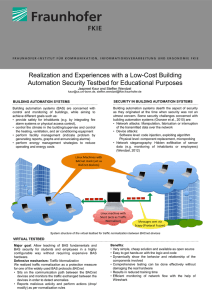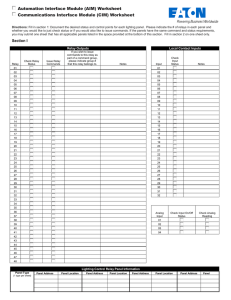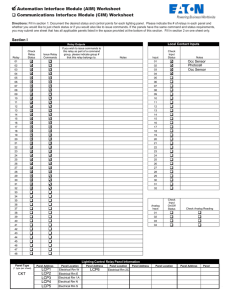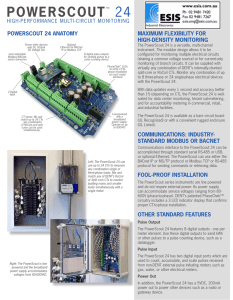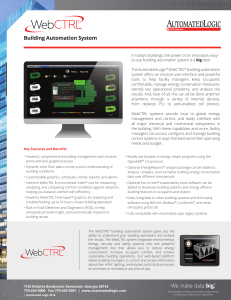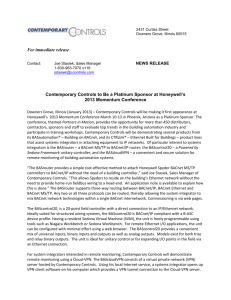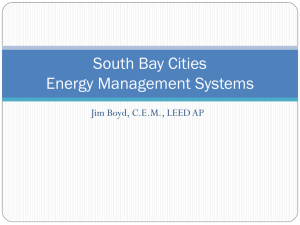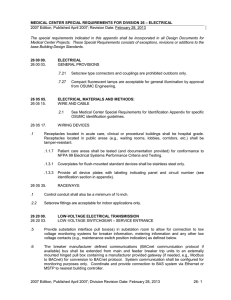By David Fisher, Member ASHRAE One signature feature of BACnet
advertisement
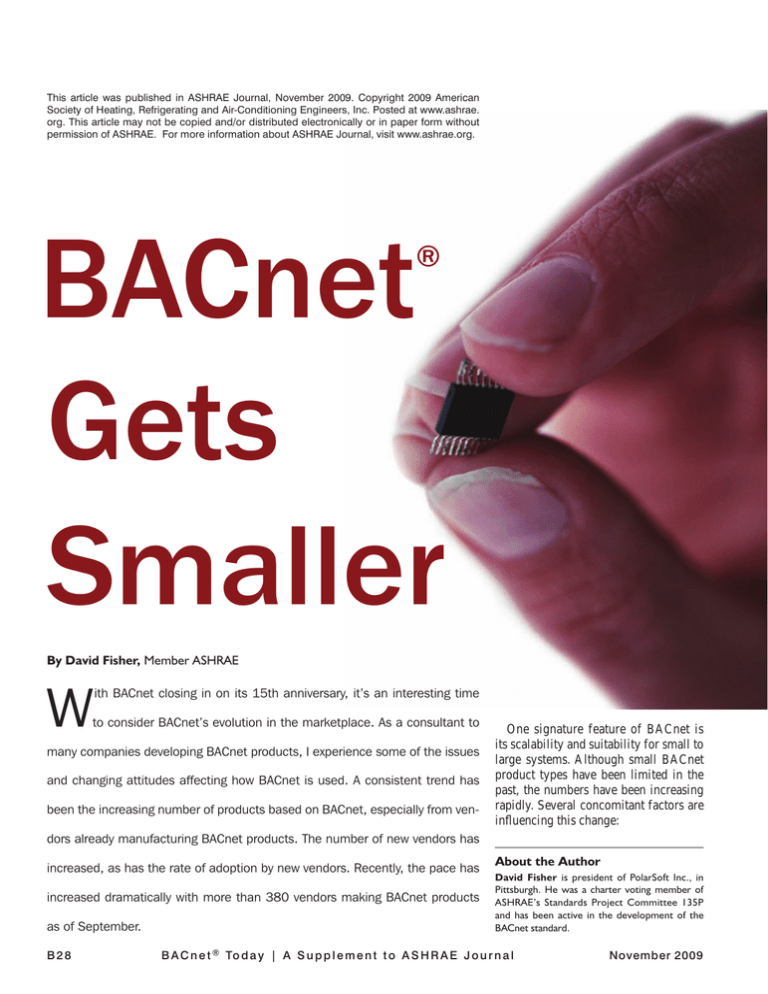
This article was published in ASHRAE Journal, November 2009. Copyright 2009 American Society of Heating, Refrigerating and Air-Conditioning Engineers, Inc. Posted at www.ashrae. org. This article may not be copied and/or distributed electronically or in paper form without permission of ASHRAE. For more information about ASHRAE Journal, visit www.ashrae.org. BACnet Gets Smaller ® By David Fisher, Member ASHRAE W ith BACnet closing in on its 15th anniversary, it’s an interesting time to consider BACnet’s evolution in the marketplace. As a consultant to many companies developing BACnet products, I experience some of the issues and changing attitudes affecting how BACnet is used. A consistent trend has been the increasing number of products based on BACnet, especially from ven- One signature feature of BACnet is its scalability and suitability for small to large systems. Although small BACnet product types have been limited in the past, the numbers have been increasing rapidly. Several concomitant factors are influencing this change: dors already manufacturing BACnet products. The number of new vendors has increased, as has the rate of adoption by new vendors. Recently, the pace has increased dramatically with more than 380 vendors making BACnet products as of September. B28 About the Author David Fisher is president of PolarSoft Inc., in Pittsburgh. He was a charter voting member of ASHRAE’s Standards Project Committee 135P and has been active in the development of the BACnet standard. B A C n e t ® To d a y | A S u p p l e m e n t t o A S H R A E J o u r n a l November 2009 •• Falling prices for technology components are enabling systems to bring more sophistication to designs that traditionally have been cost-constrained; •• Rising energy prices are increasing pressure to find ways to interoperate more efficiently and to use increasingly complex strategies to coordinate and automate; •• Rising labor prices are making the reduced training and maintenance cost of standards-based devices more attractive; •• Rising costs for copper wire are encouraging designers to rethink how to distribute sensors and controls; and •• The demand for easy integration and interoperability is increasing as owners and managers want to squeeze more out of what they have, and get more out of new purchases. What is a Small Device Anyway? The rapid pace of technology change has lead to dramatic increases in capability, as well as significant reductions in overall size and power requirements for microprocessor-based devices. As a result, it is common to see tiny components that are physically dwarfed by older designs and yet are far more capable than their larger cousins. This BACnet/IP shrinkage in size and cost allows microprocessors to be used in places that were never feasible before, or the applicaController tion of more horsepower in previously constrained environments. But in the end, cost MS/TP is king. Manufacturers don’t add features that increase cost unless customers demand them. The emergence of so many new BACnet devices means the demand exists. days of building automation was to use multiplexing devices that allowed the remote location of sensors and actuators to be physically removed from the controller. The same idea can be used with BACnet MS/TP devices for controllers that can act as MS/TP BACnet clients. Controllers are on the market that can operate as centralized controllers with direct connection to sensors, or as decentralized controllers with client connectivity to dedicated server devices. When mixing devices across manufacturers, it’s important to check the details. For example, most controllers that have client capability using BACnet will use dynamic device binding, which uses the so-called Who-Is and I-Am BACnet services, to locate server devices. The client capability is defined by the BACnet Interoperability Building Block (BIBB) called DM-DDB-A that is defined in Annex K of BACnet. For even greater flexibility, some clients support dynamic object binding, that makes use of the WhoHas and I-Have services (defined by the BIBB DM-DOB-A) as a means of locating devices containing well-known objects (“OutsideAirTemp,” etc.). These features of BACnet cannot be implemented in a MS/TP slave device. Sensor or actuator devices that are MS/TP slaves Segment can’t work with such controllers unless the controller also provides support for static binding. Router Routers Although all BACnet-based sensor/actuator and controller devices can be used in small systems, the real cost savings can be significant as system size increases. The scalability features of BACnet make it easy to expand into large systems, and to integrate and interoperate across vendors and system types. Figure 1: Typical BACnet networks include several types of LAN Coupling different types of local technology and couple each physical segment together using router area network (LAN) technoloSensors Traditionally, control- or router-controller devices. gies together, for example MS/ lers have used sensor and TP and Ethernet 8802-3, requires actuator devices that are hard-wired directly to the controller. the use of a BACnet router. Routers connect to two or more, usuAlthough there is nothing wrong with this philosophy, it poten- ally different, LANs and listen continuously to the network traffic tially uses more copper-based wiring, as sensors and actuators on each LAN. Messages on one LAN that are destined to travel must be home-run to the controller. Using BACnet’s Master- to another LAN are recognized by the router and repeated when Slave/Token-Passing (MS/TP) as a sensor or field bus allows necessary, effectively jumping from one LAN to another. placement of the sensor and actuator devices along a single The orange boxes in Figure 1 represent MS/TP devices common wiring route that shares the communication bus with daisy-chained on an MS/TP segment. These segments connect the controller and other BACnet controllers on the same segment to BACnet routers, which connect to a common Ethernet LAN up to 5,000 ft (1524 m) long. This practice can reduce wiring using BACnet/IP. The routers may also run simultaneously as cost, but controller designers must balance those savings against BACnet controllers. This feature is common in larger controlperformance issues. Do not overburden the MS/TP segment lers from a number of vendors. MS/TP segments are limited to a maximum of 32 devices unwith too many devices, since this can reduce the rate at which less repeaters are used, and a total of no more than 255 devices, sensor readings can be taken and actuator positions updated. These issues hearken back to the shift away from central- only 128 of which can be MS/TP masters. When there are a large ized to decentralized control. A common practice in the early number of master devices, the token rotation time can slow overall November 2009 B A C n e t ® To d a y | A S u p p l e m e n t t o A S H R A E J o u r n a l B29 performance. An increasingly popular technique is to reduce the number of master devices on each segment by adding more segments. Using a single MS/TP segment router makes this doctrine more costly. Some BACnet routers can provide multiple MS/TP segments that reduce the cost, as well as increase performance. Be certain that the router provides independent MS/TP ports and not an integral multiport repeater. By having multiple MS/TP ports, the router can be located more centrally within the space, reducing the number of devices on each trunk segment. This is considerably less expensive than having a dedicated router for each segment. Again, the falling cost of technology has helped to push more capable microprocessors with larger memory resources into these kinds of devices. At the same time, single MS/ TP port routers are becoming more competitive with increased demand in the marketplace and lower overall costs. To simplify installation and maintenance, many BACnet routers include a Web server interface. This allows configuration and maintenance of the router using a Web browser. By eliminating the need for proprietary tools to set up the router, these systems can be easier to install and maintain. Changes to BACnet That Benefit Small Devices There have been a number of changes and additions to BACnet that directly affect smaller devices. As these changes find their way into commercial implementations it helps to fuel the growth of BACnet in terms of new classes of devices that can be more easily implemented. In the past few years we’ve seen significant growth in lowcost BACnet interfaces for sensor devices. Since these devices typically don’t have a large number of BACnet features, some vendors have chosen to implement MS/TP slave devices for their BACnet interfaces. Although there is a fairly small difference in complexity between an MS/TP master and slave implementation, it can be a factor in extremely small microprocessor designs. There are a number of new devices on the market based on the MS/TP slave approach. A major drawback to these slave devices is their inability to participate in BACnet dynamic device binding, which is a popular and labor-saving/maintenance-saving feature. The 2004 BACnet standard introduced the concept of an MS/TP Slave Proxy, which is a functionality that can be added to BACnet routers or router-controllers. The slave proxy uses a simple procedure to locate slave devices and then perform dynamic binding functions on their behalf (as their proxy). Although this capability is uncommon now, expect to see a rise in popularity as more slave devices become available. Sensed or measured values in BACnet tend to fall into three categories: binary (on/off), multistate discrete values (1, 2, 3, 4, etc.), and real (floating point) values like 72.8°F (26°C). Although it’s possible in BACnet to use so-called nonstandard object properties that return other data types such as character strings, dates/ times, and double-precision floats, many BACnet client devices and programs have limited or no support for them, despite that they are allowed in the standard. As a result, most BACnet device designers tend to restrict their use of BACnet’s rich object model to a narrow set of what the standard allows through standard object B30 Online Resources for BACnet The “unofficial” official BACnet committee Web site: www.BACnet.org The BACnet International Web site: www.bacnetinternational.org types such as analog, binary and multistate object types. All of this may change now with the proposed Addendum w to the 2008 standard. This addendum extends the available “value objects” beyond simply analog value, binary value and multistate value to include: character string, datetime, large analog (double), bitstring, octet string, time, date, integer (signed), positive integer (unsigned), date pattern, time pattern and datetime pattern value objects. Less is More With a rapidly expanding array of products from a large and growing number of manufacturers, BACnet is more than ever the leading choice for open and sustainable interoperability between devices from different vendors and across different disciplines. Even sensor and actuator devices can provide BACnet benefits, and at competitive cost. Router options allow for flexible configuration and connectivity, while retaining important management features that simplify installation and maintenance. Advertisers Index/Reader Service Information Two fast and easy ways to get additional information on products and services in this issue: 1. Visit the Web address below the advertiser’s name for the ad in this issue. 2. Go to www.ashrae.org/freeinfo to search for products by category or company name. Plus, link directly to advertisers’ Web sites or request information by e-mail, fax or mail. Company Web Page Page Alerton...................................................................................................... B13 info.hotims.com/25210-55 BACnet International............................................................................... B27 info.hotims.com/25210-54 Contemporary Controls Systems.......................................................... B22 info.hotims.com/25210-52 Distech Controls........................................................................................ B5 info.hotims.com/25210-46 Distech Controls......................................................................... B3rd Cover info.hotims.com/25210-47 KMC Controls........................................................................................... B21 info.hotims.com/25210-53 MBS Software.......................................................................................... B12 info.hotims.com/25210-45 National Environmental Protect............................................................. B17 info.hotims.com/25210-48 National Environmental Protect............................................................. B23 info.hotims.com/25210-49 Reliable Controls.................................................................... B2nd Cover-1 info.hotims.com/25210-50 Viconics...................................................................................................... B7 info.hotims.com/25210-51 Watt Stopper/Legrand.................................................................B4th Cover info.hotims.com/25210-56 For information on advertising in the ASHRAE Journal, contact Greg Martin at 678-539-1174 or gmartin@ashrae.org. B A C n e t ® To d a y | A S u p p l e m e n t t o A S H R A E J o u r n a l November 2009
